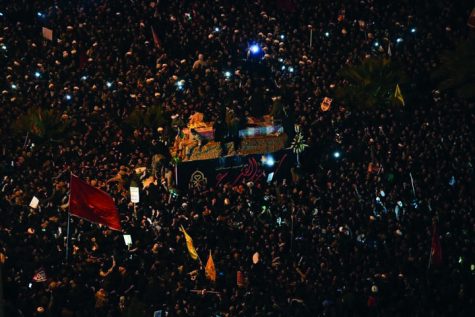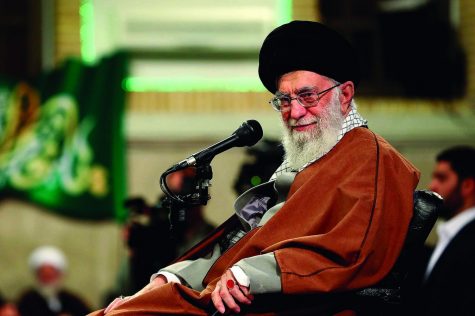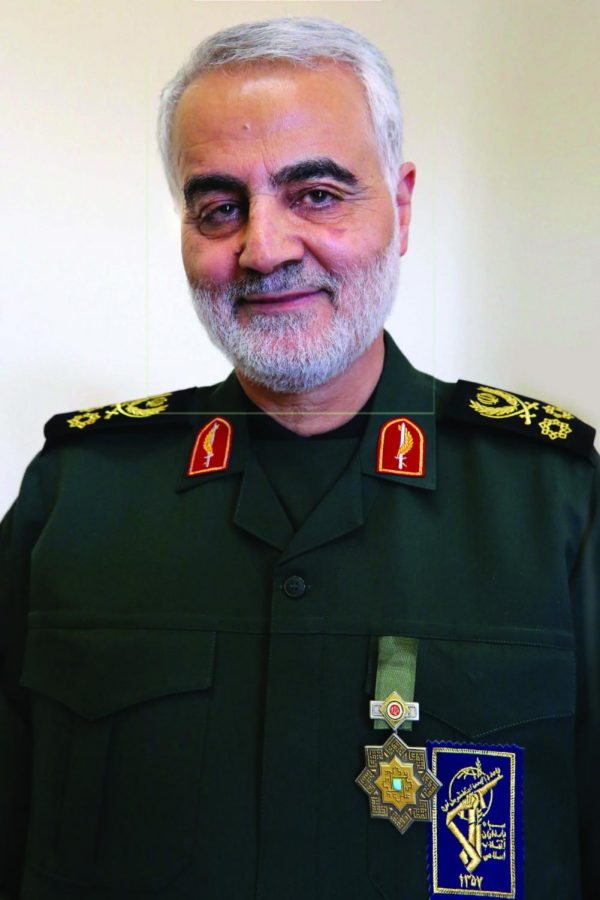Tensions Rising
Examining the unease between Iran and U.S.
Iranian Maj. Gen. Qasem Soleimani on Mar. 11, 2019. Soleimani was assassinated on Jan. 3 by an airstrike ordered by President Trump. Wikimedia Commons.
February 12, 2020
On Jan. 2, President Donald Trump ordered the assassination by airstrike of Iranian Revolutionary Guard, Gen. Qasem Soleimani.
Seemingly overnight, the American consciousness and the world at large feared war. The biggest question on people’s minds, why? Who was Soleimani and why did the administration feel the need to assassinate him? With tensions high, we take a look at the circumstances that led to and followed this assassination.
SOLEIMANI
Gen. Qasem Soleimani was part of something called the Islamic Revolutionary Guard Corps or IRGC for short. This is a military organization in direct service to the Supreme Leader of Iran, Ayatollah Ali Khamenei.
The IRGC was formed after Iran’s 1979 revolution and quickly became the military force devoted to protecting the Islamic system, though their role has grown over the years. In April last year, President Trump designated the IRGC a foreign terrorist organization.
For some more context on Soleimani’s influence, we must discuss Iranian politics. For those who have taken AP Comparative Politics, you might recall that Iran is a “theocracy,” a system of government wherein religious leaders are the political leaders as well. Meaning, “Supreme Leader” is not just a title, Khamenei is the most powerful man in Iran.
Knowing that, Soleimani has been called the most powerful man in Iran after Khamenei, certainly being the most powerful military figure in Iran.
Soleimani was in Baghdad, Iraq that day to meet with political and military allies and supposedly coordinate an “intensifying campaign of rocket strikes to maim and kill some of the 5,000 American troops based there,” according to Business Insider.
While in Baghdad, his convoy was destroyed, and Soleimani and nine others died in an airstrike ordered by President Trump.
This was not the first time Soleimani’s assassination was discussed as an option within the administration.
In June of last year, the at-the-time Foreign National Security advisor, John Bolton, encouraged Trump to assassinate Soleimani after Iran brought down a U.S. drone. Trump actually declined this at the time, stating he would assassinate Soleimani if Iran’s aggression resulted in the death of an American, according to NBC News. Trump also said that he would have the final signoff on the assassination.
Shortly before the assassination, then, an Iranian proxy attack in Iraq killed a U.S. contractor and four U.S. service members. For this reason, the airstrike on Soleimani was proposed.
Afterwards, many related closely with Trump and Trump himself have said that Soleimani was a threat and had been planning future attacks on Americans. Secretary of State Mike Pompeo said that his death made the world a safer place, albeit amidst recommendations from the U.S. for their citizens to leave Iraq, the location of the airstrike.
Most conceded that Soleimani was a threat and overall thorn in America’s side, but many doubt if the benefits of his death were worth the possible negatives, especially upon seeing Iran’s reaction.
IRAN’S REACTION

Mourners surround a truck carrying the flag draped coffins of Gen. Qassem Soleimani and his comrades in the holy city of Qom south of the capital Tehran, Iran, Monday, Jan. 6, 2020. The men were killed in a U.S. drone strike on Friday, Jan. 3 in Iraq. The funeral drew a crowd said by police to be in the millions in the Iranian capital, filling thoroughfares and side streets as far as the eye could see.
On Jan. 6, Soleimani’s funeral was held in Tehran, drawing massive crowds reportedly in the millions.
Many spoke at his funeral, one of note being his daughter, Zeinab, who warned of an ominous threat to America amidst cheers.
“The families of the American soldiers in western Asia,” Zeinab said, “will spend their days waiting for the death of their children.”
Khamenei prayed over Soleimani’s casket at the funeral, weeping with the millions of attendees. He was joined by Iranian President Hassan Rouhani, Soleimani’s successor Esmail Ghaani, and several other high ranking figures.
“God the Almighty has promised to get his revenge, and God is the main avenger,” Ghaani said. “Certainly actions will be taken.”
The Iranian state television put out a rather alarming video on Jan. 5, showing Trump’s American flag tweet slowly turn into a flag covered coffin. The “likes” listed at the bottom of the tweet read “killed” instead and went upwards of 143,000. At the end of the video, the screen read #SEVEREREVENGE.
“We promise to continue down martyr Soleimani’s path as firmly as before with help of God, and in return for his martyrdom we aim to get rid of America from the region,” Ghaani said.
In response to the assassination, Iraq has expressed solidarity with Iran and demanded all American troops leave Iraq. Additionally, leader of Iranian backed militant group Hezbollah declared that American bases and personnel are fair game for retribution and many others within Iran have expressed similar sentiment. The U.S. Embassy in Saudi Arabia warned of the increased likelihood of drone and missile strikes.
According to TIME, head of the IRGC aerospace program, Gen. Amir Ali Hajizadeh, said in a statement on TV that they will only be satisfied when America is gone from the region. “Firing a couple of missiles, hitting a base or even killing Trump is not valuable enough to compensate for martyr Soleimani’s blood,” Hajizadeh said.
For his part, Trump threatened to retaliate against any Iranian aggression with attacks on Iranian cultural sites. This threat was criticized for its likelihood to harm Iranian civilians, but Trump pushed back against such criticism.
“They’re allowed to kill our people. They’re allowed to torture and maim our people. They’re allowed to use roadside bombs and blow up our people. And we’re not allowed to touch their cultural sites? It doesn’t work that way,” Trump told reporters.
IRANIAN RETALIATION
As many predicted, Iran retaliated. On Jan. 8, Iran sent 16 missiles to two U.S. air bases in Iraq.
Al-Assad in western Iraq suffered the brunt of the attack, being struck by eleven missiles, while Erbil, another target in the north, had one missile fall near it. The other four missiles failed to reach their targets.
Luckily for everyone, there were no casualties, Trump tweeting of “minimal damage” and “Iran standing down” shortly after. The troops stationed at the air bases had gotten advance warning of the incoming strike, and were able to scramble to take cover before the missiles hit.
For a while, the predominant idea was that this was simply a warning shot, Iran not aiming for any casualties. This was an important question, after all their country has called ours the “Great Satan,” so it was important to know whether they were seeking to destroy us or threaten us.
Though Hajizadeh said Tehran wasn’t aiming to kill anyone, outside experts doubt this, Chairman of the Joint Chiefs of Staff Mark Milley becoming the first to suggest Iran had indeed sought to kill U.S. soldiers as well as destroy vehicles. As of now, U.S. officials have dismissed the notion that Iran deliberately missed the troops, according to CBS News.
Considered the first and definitely not the last shot from Iran, people braced for further retaliation.

At this time, Ukraine International Airlines Flight 752 crashed outside Tehran. The plane departed from Imam Khomeini International Airport early in the morning (6:12 a.m. local time), carrying 167 passengers and nine crew members to Kiev, Ukraine. Among the passengers the majority Iranian and Canadian, there being 82 Iranians and 63 Canadians on board.
The plane vanished minutes into its flight, only to be reported crashing south of Tehran an hour later. There were no survivors.
Immediately, the world was suspicious of Iran, whose state media claimed the crash was a result of engine failure, despite aviation experts’ claims that Iran had no way of knowing that.
Canadian Prime Minister Justin Trudeau expressed his condolences to the families of the 63 Canadians killed and promised that the Canadian government will ensure this crash is investigated properly and thoroughly.
According to USA Today, Trudeau became the first leader to publicly confirm intelligence from Canada and its allies that indicated Iranian surface-to-air missiles had struck the aircraft.
Though initially disputing this, Iran admitted on Jan. 11 that, due to “human error,” the military unintentionally shot down the plane. The military statement issued to the state media claimed the plane was mistaken for a “hostile target” and the tensions led them to act mistakenly. They apologized and stated they would upgrade their systems to ensure this didn’t happen again.
Hajizadeh said his unit took full responsibility and that upon hearing the news he “wished [he] were dead,” according to USA Today.
As a result, on Jan. 14, Iran claimed that dozens had been arrested because of the tragedy. President Rouhani, though, still asserted that the root cause of this situation was the U.S. and its escalation of the tensions in the past weeks.
The news of Iran’s involvement in the plane crash reinvigorated an anti-government sentiment that had subsided following Soleimani’s death, and protesters took to the streets of Tehran.
Protesters held a candle-light vigil for the victims of the crash, calling for Supreme Leader Khamenei to step down, chanting “Death to the dictator” and “Death to the liar,” according to CNN.
This all culminated in Iranian authorities attempting to disperse the crowds, first firing tear gas and other non lethal means, but then firing live ammunition to disperse protesters, leaving many wounded.
Many have called the situation in Iran a “Chernobyl Moment,” CNN defining it as “an analogy to the way the 1986 nuclear disaster in the Soviet Ukraine exposed all the incompetence, state deception and rot in that regime.”
OUR REACTION
These events have not only shaken Iran up. The United States, far away from the conflict, has reacted in different ways to Iran.
For teachers like David Jafari, the feeling of unrest has not subsided. Life has not become any less hectic in Iran. Jafari’s father is his only Iranian family member currently living in the United States.
“The Middle East my whole life has just been complete chaos,” Jafari said.
The government of Iran is vastly different from the United States. Iran is an authoritarian government under control of the Supreme Leader Ali Khamenei. Iran is extremely restrictive of speech, with the country being one of the biggest jailers of journalists.
“I think that the people really want to be free and they know what they’re missing. Every time they try to kind of have an uprising or tell the government how unhappy they are, the [Iranian] government just kills a couple hundred people,” Jafari said. “All these people just go back to their houses because their parents tell them to come in because this isn’t going to work.”
Does this mean that America should come in and save the day for Iranians?
“I think the worst thing the U.S.A. can do is become involved again,” Jafari said.
This is far from the first time the United States and Iran have been at odds. The United States has a long and complicated relationship with Iran.
It all started with the Anglo-Iranian Oil Company, or the “AIOCC.” The AIOCC, largely controlled by the British, profited off the vast oil supply of Iran. Prime Minister Mohammad Mosaddegh wanted to bring more of the profits of the oil to Iran. In 1951, after failed negotiations between Iran and Britain, the Iranian parliament nationalized the company, bringing the power of the company back to Iran.
The British did multiple things to try to change Iran’s mind, including an oil boycott in 1952 and military action. Nothing stopped Mosaddegh’s government.
Thereafter the United Kingdom initiated “Operation Boot,” which involved overthrowing the democratically elected Prime Minister Mosaddegh in favor of a West-backed “Shah,” or monarch, Mohammad Reza Pahlavi.
In 2013, the United States government confirmed that the operation was done with help from the United States. The United States maintained the Shah’s power through creating pro-Shah propaganda and staging pro-Shah riots.
The monarch returned control of the company and allowed for oil money to be siphoned to the West.
“The Shah was hated by many because [Iranians] looked at them as being an American puppet,” said Jafari. “If the United States goes in there and tries to put in a U.S. backed leader, then it’s going to lead to the same situation.”
From the formation of Israel after World War II, to the Eisenhower Doctrine meant to discourage Soviet influence in the region, the United States has a long history of influencing the Middle East.
This trend has continued to this day. Since 9/11, the United States has been involved with conflicts in Iraq and Afghanistan. The United States, as a part of the “War on Terror,” is also currently fighting other terrorism organizations in the area.
Choir director Ben Silvermintz has served in the military multiple times over the last 20 years. In doing so, Silvermintz has been a part of the conflicts in the Middle East during the “War on Terror” and reminds us of the ever present tensions there, even in times of peace.
“There is no delineation between a hot zone and cold zone. You could walk around ’inside the wire’ so to speak and a mortar round could land ten feet away. Or you could be working at an Entry Control Point and a vehicle could just drive straight up to you and explode,” said Silvermintz. “The guy behind you on your team guarding the flag could tag you out in that scenario.”
WHAT THIS MEANS FOR AMERICA
This all leads to the burning question: will the tensions between Iran and America lead to World War III?

David Jafari’s father is Iranian and his extended family is currently living in Iran.
Weeks after the attacks took place, the answer is now clear: no. Despite the uproar from the media in the first week of the year, coverage of the tensions has died down significantly. America has moved on.
Still, there are many things to take away from what has happened over the last month.
Firstly, social media’s response. After the missile strikes in the first week of January, the internet blew up with dark jokes about war, getting drafted, and even World War III.
Since the rise and spread of social media, there hasn’t been a new act of war from the United States. The uproar on the internet was incredible, and we didn’t even go to war. If the United States in the future does decide to actually go to war, the missile strikes in Iran have just given a hint of what the reactions on social media could become.
Second, Trump and Islamophobia. Trump has been criticized for islamophobic policy throughout his presidency. Was this strike done for the greater good according to the right, or was this strike purely fueled by Islamiphobia?
Third, the upcoming presidential election. The 2020 campaign is going strong. Political scientists have argued whether or not Trump’s attack was motivated by the upcoming election. Does the strike on Iran suggest Trump is fearing his chances for 2020? Is a move like this meant to distract from the impeachment trial?
All of this leads to one final question: what can we do? The tensions between America and Iran are extremely complicated. In a situation like this, what can an average person do in response to such a chaotic event?
“Honestly, I’m not super interested in hearing about world problems from someone who can’t throw trash away, flush a public toilet or show up to a class or place of employment on time,” said Silvermintz. “Service and patriotism are not one-day events and they don’t require grand pronouncements or social media posts. I think the ‘little things’ matter and the most impactful students are doing great work all the time without necessarily receiving credit for it. That’s service, and service is the ultimate patriotism.”

